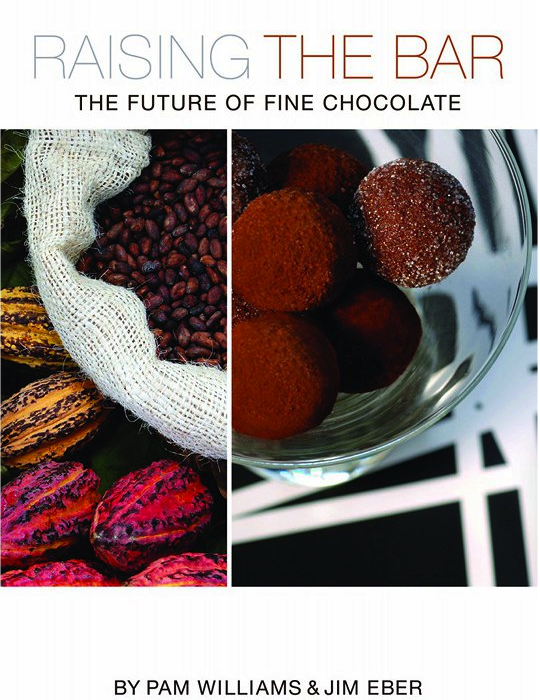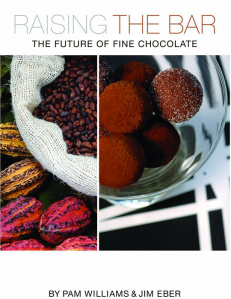The second section of Raising the Bar: The Future of Fine Chocolate by Pam Williams and Jim Eber, opens up in November 2010 with Art Pollard, of Amano Chocolate, a waking up in the passenger seat alongside his friend as they traverse the mountainous region of Venezuela’s Henri Pittier National Park:
The road narrowed as they climbed. Tight hairpin turns and blind curves seemed barely big enough for a single car to pass. And now it was raining. Torrentially. Rivers of water ran down the road and soon small landslides followed. The road doubled back on itself revealing a deep mountain chasm. Art looked to the bottom: a bus.
Gripping stuff, right? I thought so. A following paragraph continues on with the travelers as they approach the town of Choroni and sets a beautiful scene:
[…] As the rain diminished to a drizzle, the mountains and the Caribbean Sea expanded before the windshield. Huge strands of bamboo planted years ago to keep the original dirt trail from washing away lined the road. Tiny shops appeared selling arepas…
Why are Art and his friend making such a dangerous trek? To meet the farmers in Chuao village who have helped grow and develop cocoa beans, and to present one of the products of their labor: Amano chocolate bars. This a great way to start off the section—mostly concerned with the labor that goes into creating the fine chocolate, including the current economic, social and political situations concerning farming and the cocoa farming population—by hooking the reader and giving the topic a human face.
However, the book only stays with Art and the members of the Chuao village for a few opening pages. Then, the reader is moved on to another story. Introductions to the other three parts begin like this as well: a brief narrative hook focusing on a person that quickly transitions to a discussion of issues on a broader and more abstract level. The book uses Art for a quote or two but doesn’t return to his and villagers’ story. (Readers will be introduced to many people that are only used for quotes or brief narratives, so much so, that it gets distracting trying to keep track.)
Similar books intertwine narrative with knowledge, but Raising the Bar places information over story. It does so to its detriment, as evidenced in the first part, “Seeds of Change: Genetics and Flavor.” There, after the narrative hook is finished, the reader is thrown into a sea of acronyms and science with little way of understanding what it all means. Perhaps the reason for this can be found in the notice, prior to the book proper, in which the authors ask readers “looking for motives, morals and plots [… to] stop.” The authors, a veteran chocolatier and marketing writer, may have tried to avoid accusations of bias, but they also eschewed a narrative that would have given context to the information they provide and a forward momentum for the reader. The book is supposed to be a short overview, but it might take readers far too long to get through.
It also seems that Williams and Eber were somewhat unsure of the book’s intended audience. Instead of starting off with more accessible topics such as marketing and flavor—the topics of the latter half of the book—it starts off of by discussing genetics. There is also an inconsistent tone to the book: while it avoids a dry presentation of facts, the voice occasionally gets too informal—the occasional swear or a meta-reference to writing the book—that doesn’t gel with the rest of the writing. I began to wonder if the book was better suited for a niche blog than for a mass audience publication.
The presentation of the book aside, the information presented is invaluable not only to the avid chocolatier but anyone interested in food studies, or concerned with how and what they eat. It captures a spread of interesting trends in contemporary food culture: the increasingly curious consumer, alternative ways of farming, flavor experimentation and the application of genetics in food production.
There are stories to be told about the pursuit of better chocolate, better ways of making chocolate and narrowing down the definition of fine chocolate. But the authors could have gone deeper and further with these stories; they only hint at them. As a result, Raising the Bar is a great resource; unfortunately, though, it is not a very entertaining book to read.
Raising the Bar: The Future of Fine Chocolate was published by Wilmor Publishing Corporation on October 22, 2012.
Alex J. Tunney recently received his M.F.A. in Creative Writing (Non-Fiction) from The New School. He lives and writes on Long Island.



1 Comment
Pingback: “Review: Raising the Bar @ The Inquisitive Eater | Queeroid